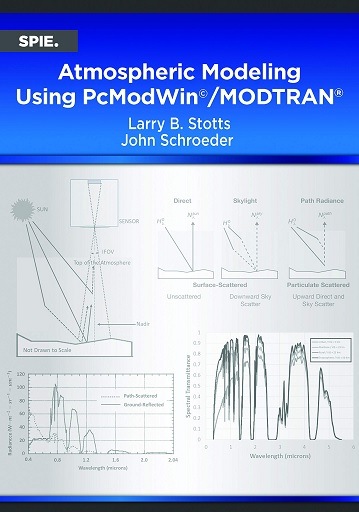Atmospheric Modeling Using PcModWin/MODTRAN, PcModWin / MODTRANを使用した大気モデリング, 9781510628052, 978-1-5106-2805-2

Description
MODTRAN is a powerful program capable of describing atmospheric absorption, scattering, and emission paths, but it has a complicated computer-card input structure; a custom user interface, PcModWin, was introduced to minimize setup and error-mitigation issues. The instruction manuals for these programs provide over 80 test cases, which are instructive for intermediate to advanced users but do not provide detailed explanations. This book is intended to help beginners learn how to perform analysis using MODTRAN/PcModWin by exploiting these test cases. Specifically, many of the cases are used to illustrate how to navigate the PcModWin menus to solve the given problems. The book also provides the underlying mathematics and atmospheric physics incorporated into MODTRAN.
Contents:
Chapter 1 Introductory Material
1.1 Introduction
1.2 Radiometric Parameters
1.2.1 Radiant flux (radiant power)
1.2.2 Radiant intensity
1.2.3 Radiance
1.2.4 Radiant flux density (irradiance and radiant exitance)
1.2.5 Bi-directional reflectance distribution function
1.2.6 Directional hemispheric reflectance
1.2.7 Specular surfaces
1.2.8 Lambertian surfaces and albedo
1.2.9 Blackbody radiation sources
1.3 Blackbody Radiation Sources
1.4 Mie Scattering Theory
1.5 Atmospheric Transmittance and Scattering
1.6 Essential Concepts in Radiative Transfer
1.6.1 First-order RTE solution
1.6.2 Radiative transfer equation for a single, homogeneous particulate layer
1.6.3 Radiative transfer equation for multiple, homogeneous particulate layers
1.7 References
Chapter 2 MODTRAN Modeling Capability
2.1 Introduction
2.2 A Short MODTRAN History
2.3 New MODTRAN User Interface
2.4 General MODTRAN Calculation Details
2.5 MODTRAN Transmittance and Radiance Model Definitions
2.5.1 VSWIR modeling
2.5.2 MWIR-LWIR modeling
2.5.3 Maritime remote sensing modeling
2.6 MODTRAN Spherical Refractive Geometry
2.6.1 MODTRAN geometrical layout: general problem
2.6.2 MODTRAN geometrical layout: uniform path
2.7 Selecting Atmospheric Properties
2.7.1 More on aerosol characterization in MODTRAN
2.7.2 Available aerosol models
2.7.3 Clouds
2.7.4 Fog
2.7.5 Aerosol angular scattering functions
2.8 The NOVAM Aerosol Model
2.9 MODTRAN DIORT Option
2.10 MODTRAN LBL Radiative Transfer Option
2.11 References
Chapter 3 Transmittance Calculations
3.1 Introduction
3.2 General Comments on MODTRAN Light Transmission in the Atmosphere
3.2.1 Molecular absorption
3.2.2 Molecular scattering
3.2.3 Aerosol extinction
3.2.4 Atmospheric transmission
3.3 Effects of Wavenumber Resolution on Atmospheric Transmittance Representation
3.4 Example MODTRAN Calculation Procedure
3.5 MODTRAN Test Cases
3.6 Calculating Spectral Transmittance: 1500mGround Test Case
3.7 Spectral Resolution Selection
3.8 Calculating Spectral Transmittance: New Model Atmosphere
3.8.1 Calculating spectral transmittance: CD2c3_USS.ltn test case
3.8.2 MODTRAN A-Plus cards (FLEXIBLE AEROSOL MODEL) and PcModWin
3.8.3 Aerosol extinction profiles: MODTRAN input entries
3.8.4 NMA user-defined properties: AuxilSpecies.ltn test case
3.8.5 Angstrom's law
3.8.5.1 Relationship between Angstrom's law and the Koschmeider equation
3.8.5.2. Spectral transmittance with Angstrom's law
3.9 Spectral Transmittance: Navy Maritime Aerosol Model
3.10 Spectral Transmittance: NOVAM Aerosol Model
3.11 Long-Path Refraction/Surface Meteorological Range (Visibility)
3.12 Important Sensor-Related Functions in PcModWin/MODTRAN
3.12.1 Scanning function
3.12.2 MODTRAN Filter Function
3.13 References
Chapter 4 Atmospheric Spectral Radiance
4.1 Introduction
4.2 General Comments on Solar and Lunar Calculations in MODTRAN
4.3 Plotting Options in MODTRAN
4.4 Calculating Spectra Transmittance and Radiance: Radiance with Scattering Test Case
4.5 Calculating Spectral Radiance: Radiance with No Thermal Scattering Test Case
4.6 Calculating Spectral Radiance: Thermal Radiance Only Test Case
4.7 Calculating Spectral Irradiance: Direct Solar Irradiance Test Case SolarIrrad.ltn
4.8 Calculating Spectral Transmittance: AnLBLTemplate.ltn Test Case
4.9 Calculating Spectral Transmittance: lblThmNoMS1600wn_highres.ltn Test Case
4.10 Calculating Spectral Transmittance: VertStructAlg.ltn Test Case
Chapter 5 Multiple Scattering in MODTRAN
5.1 Introduction
5.2 Correlated k-Distribution
5.2.1 k-distribution method
5.2.2 Correlated k-distribution method
5.2.3 Correlated k-distribution method implementation in MODTRAN
5.3 Calculating Spectral Radiance: CorrelatedK.ltn Test Case
5.4 Calculating Transmittance and Spectral Radiance: SolarIsaacsCK.ltn Test Case
5.5 Calculating Spectral Radiance: SolarScaledCK.ltn Test Case
5.6 Multiple-Lines-of-Sight Option
5.6.1 CARD 3D for the DISORT algorithm
5.6.2 Calculating transmittance and spectral radiance: ElevAngMWIRthm.ltn test case
5.6.3 Calculating spectral radiance: lut01ASC.ltn test case
5.6.4 Calculating spectral radiance and transmittance: lut01thm.ltn test case
5.6.5 Calculating spectral radiance and transmittance: lut02thm.ltn test case
5.7. References
Chapter 6 Surface Reflectance in MODTRAN
6.1 Introduction
6.2 Background
6.3 Spectral BRDF and Lambertian Options in MODTRAN
6.4 Spectral Lambertian and BRDF Options in PcModWin
6.5 Calculating Spectral Scattered Radiance: Lambertian.ltn Test Case
6.6 Calculating Spectral Scattered Radiance: MODIS.ltn Test Case
6.7 Calculating Spectral Scattered Radiance: BRDF.ltn Test Case
6.8 Calculating Spectral Scattered Radiance: seaBRDF
.ltn Test Cases
6.8.1 User-defined line of sight
6.8.2 Spectral aerosol profile (SAP)
6.8.3 Compute segment radiance: DISORT
6.9 References
Chapter 7 Clouds and Fog in MODTRAN
7.1 Introduction
7.2 Clouds and Fog Basics
7.3 Engineering Equations for Light Propagation through Clouds
7.4 PcModWin Cloud Settings for Aerosols and Clouds Type Selection
7.5 Calculating Transmittance and Spectral Radiance: UserDefinedCir.ltn Test Case
7.6 Calculating Transmittance and Spectral Radiance: UserDefinedCld.ltn Test Case
7.7 PcModWin Cloud Settings for Aerosols and Clouds Type Selection
7.8 Calculating Transmittance and Spectral Radiance: CirrusProfile.ltn Test Case
7.9 PcModWin FOG Settings for Aerosols and Clouds Type Selection
7.10 Use of the Army Vertical Structure Algorithm with Aerosols and Clouds/Fog
7.11 References
Chapter 8 Special Topics
8.1 Introduction
8.2 Using MODTRAN with Radiosonde Data
8.3 Key Focal Plane Array Metrics and MODTRAN/PcModWin
8.3.1 Signal-to-noise ratio definitions
8.3.2 Responsivity
8.3.3 Optical signal-to-noise ratio
8.3.4 Noise-equivalent power
8.3.5 OSNR for an extended source with background optical radiation
8.3.6 Noise-equivalent temperature difference
8.4 Koschmeider Equation Versus MODTRAN
8.5 References










